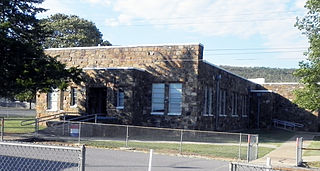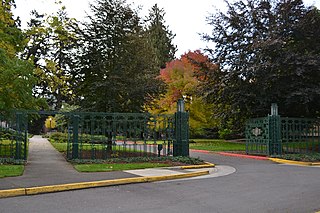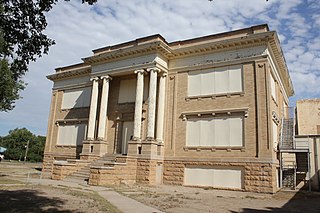
The Works Progress Administration was an American New Deal agency that employed millions of jobseekers to carry out public works projects, including the construction of public buildings and roads. It was set up on May 6, 1935, by presidential order, as a key part of the Second New Deal.

Las Animas is the statutory city that is the county seat, the most populous community, and the only incorporated municipality in Bent County, Colorado, United States. The city population was 2,300 at the 2020 United States Census. Las Animas is located on the Arkansas River, just west of its confluence with the Purgatoire River, in southeast Colorado east of Pueblo, near the historic Bent's Fort.

The Federal Emergency Relief Administration (FERA) was a program established by President Franklin D. Roosevelt in 1933, building on the Herbert Hoover administration's Emergency Relief and Construction Act. It was replaced in 1935 by the Works Progress Administration (WPA).

The Vocational Agriculture Building was built by the Works Projects Administration (WPA) in 1938 with funding from the Flagler County Board of Public Instruction and the WPA. It is located at 1001 E. Howe St., Bunnell, Florida, United States. Interestingly, it never served as a schoolhouse as it was used as Bunnell High School's vocational agriculture department and housed the local chapter of the Future Farmers of America, which is now known as the National FFA Organization. The building is also often mistaken for a one-room schoolhouse, but it actually has two large rooms and a smaller storage room. This building is one of only three structures built in Flagler County during the Great Depression with funding provided by New Deal dollars. The other two are the Bunnell Coquina City Hall and the Flagler County Jail (WPA-Built).

Land's End Observatory is a ranger observatory on the rim of Grand Mesa in Colorado. It is accessible from the Grand Mesa Scenic and Historic Byway via Land's End Road, which is about half paved and half gravel. The observatory is about 10 miles west of Colorado State Highway 65. Land's End Road descends as an all-gravel road from the observatory down to U.S. Route 50, and the observatory can be accessed from that direction as well.

Snow School is a historic school building in the rural community of Snow, Oklahoma, approximately 18 miles north of Antlers, Oklahoma. The school was added to the National Register of Historic Places in 1988.
Fewell School is a historic site located in Fewell, Oklahoma. Fewell, 10 miles east of Nashoba, Oklahoma, is a rural community in the Kiamichi Mountains of Pushmataha County, Oklahoma.

Clayton High School Auditorium is an historic structure serving the public school of Clayton, Oklahoma. Clayton is located in the Kiamichi Mountains of Pushmataha County, Oklahoma.

Dads' Gates, located on the University of Oregon campus in Eugene, Oregon, are listed in the National Register of Historic Places.

The Sedgwick County Courthouse, located at 315 Cedar St. in Julesburg, Colorado, was built during 1938-39 by the Works Progress Administration (WPA). It was listed on the National Register of Historic Places in 2007; the listing included two contributing buildings.

The Bent County High School, in Bent County, Colorado at 1214 Ambassador Thompson Blvd in Las Animas, is a historic school that was built in 1913 or 1914. It has been deemed notable for association with former U.S. Ambassador Llewellyn Thompson, Ken Curtis, and author James Michener’s wife, Mari (Sabusawa) Michener, all of whom attended the school, as well as for "its imposing, three-story, massive-columned architecture". It was designed by Swedish architect James Larson. The building was listed on the National Register of Historic Places (NRHP) in 2010.

The Las Animas Post Office is a historic Modern Movement-style building in Las Animas, Colorado that was built during 1937–38. It was listed on the National Register of Historic Places in 2008.

The International Vinegar Museum is located at 500 Main Street in Roslyn, South Dakota, United States. The museum is located in the former Roslyn Auditorium, a Depression-era brick building built in 1936 with funding from the Works Progress Administration. The building was listed on the National Register of Historic Places in 2001. The museum opened in 1999 and bills itself as the first museum dedicated to the subject of vinegar, with exhibits in its manufacture and use.

The Sebastian County Road 4G Bridge is a historic bridge in rural Sebastian County, Arkansas, United States. The bridge carries County Road 4 across an unnamed tributary of Sugar Loaf Creek southwest of West Hartford, between County Roads 1 and 243. It has two spans with a total length of 44 feet (13 m). The width is 18 feet (5.5 m) curb-to-curb and 21 feet (6.4 m) overall. The two spans rest on a single center stone pier, and both abutments are also made of stone masonry. The road deck is reinforced concrete with simple concrete railings on the sides. Built in 1940, it is a well-preserved example of a concrete bridge from the World War II era of bridge construction in the state, when steel had become scarce. The bridge was listed on the National Register of Historic Places in 1995.
The Bueyeros School is a historic school building located on State Road 102 in Bueyeros, New Mexico. The school was built in 1936 by the Works Progress Administration as part of its efforts to combat rural unemployment in New Mexico. The Bueyeros area was part of New Mexico's section of the Dust Bowl, making the school project especially important to the area. The school was one of many rural schools built by the WPA in New Mexico; as may rural school districts lacked adequate facilities, school projects were a large and necessary part of the WPA's work in the state. The school has a plain Pueblo Revival design with a stucco exterior and stone drainage spouts on the east side.

The Art Deco style, which originated in France just before World War I, had an important impact on architecture and design in the United States in the 1920s and 1930s. The most famous examples are the skyscrapers of New York City including the Empire State Building, Chrysler Building, and Rockefeller Center. It combined modern aesthetics, fine craftsmanship and expensive materials, and became the symbol of luxury and modernity. While rarely used in residences, it was frequently used for office buildings, government buildings, train stations, movie theaters, diners and department stores. It also was frequently used in furniture, and in the design of automobiles, ocean liners, and everyday objects such as toasters and radio sets. In the late 1930s, during the Great Depression, it featured prominently in the architecture of the immense public works projects sponsored by the Works Progress Administration and the Public Works Administration, such as the Golden Gate Bridge and Hoover Dam. The style competed throughout the period with the modernist architecture, and came to an abrupt end in 1939 with the beginning of World War II. The style was rediscovered in the 1960s, and many of the original buildings have been restored and are now historical landmarks.

The Frances School Gymnasium in Marion, Kentucky was built in 1938 as a New Deal era construction employment project. It was listed on the National Register of Historic Places in 1993.
The Dog Creek School, near Shady Point, Oklahoma, is a one-room school built in 1936 as a Works Progress Administration project. It was listed on the National Register of Historic Places in 1988.

Prowers Country Welfare Housing is a complex of five buildings constructed by the Works Progress Administration in 1938–41. It was listed on the National Register of Historic Places in 2009.

The Bridge over Burro Cañon, near Madrid, Colorado, was built in 1936. It carries Colorado State Highway 12, a main route linking La Veta with Trinidad, over an arroyo. It was listed on the National Register of Historic Places in 1985.


















